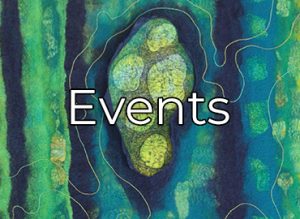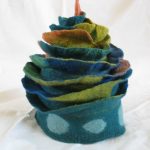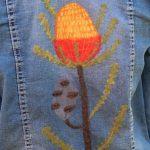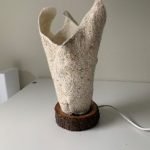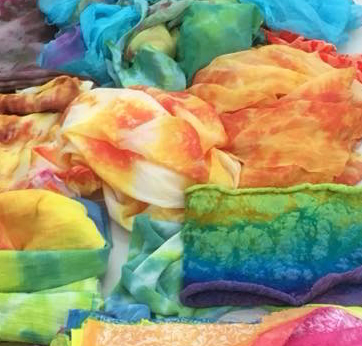
Dyeing 101 workshop with Sara Quail, Feb 2018.
Techniques and tips for dyeing silk, cotton and other cellulose fibres.
 Sara’s aim was to teach participants how to pattern silk and cotton with fibre reactive dyes using a low immersion technique-ie by applying dye directly and manipulating the fabric. This was done using basic equipment in a small work area.
Sara’s aim was to teach participants how to pattern silk and cotton with fibre reactive dyes using a low immersion technique-ie by applying dye directly and manipulating the fabric. This was done using basic equipment in a small work area.

Sara outlined the safety requirements for using the materials utilised in the workshop, as well as some mess avoidance techniques for persons and the work area. She taught participants how to mix the soda ash in which the fabric is initially soaked, and how to mix the dye in the correct proportions to achieve a range of colours. She stressed the importance of rinsing equipment to avoid contaminating the colours being mixed, and the necessity of labelling the dyes that are produced. She taught participants how to batch, cure and rinse dyed pieces to achieve the best possible dyeing results.












As well as these basic & necessary processes, Sara taught a variety of techniques that produce different effects on the finished piece. These included working flat, tray pleating, crystalline, folding, doughnut, twisting, coiling, and how to dye skeins of thread or fibre.
She had a myriad of samples including how the dye takes on different fabrics and fibres. Other uses for Fibre Reactive dyes and how they can be used to dye protein fibres like wool were discussed.
Sara also provided comprehensive notes, a list of suppliers of Fibre Reactive dyes, and some websites as references for further reading.
I think I can conclude that a messy but fun day was had by all!
Alison Higgins






Participants dyed many pieces of fabric and items, so there was no time dry them all and view the results on the day. There was quite a display at the first Feltwest meeting of the year of their achievements as well as some further exploration with the leftover dyes they took home.
